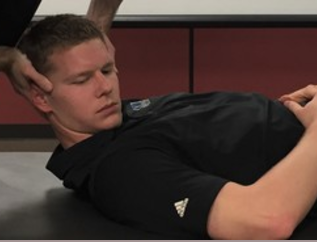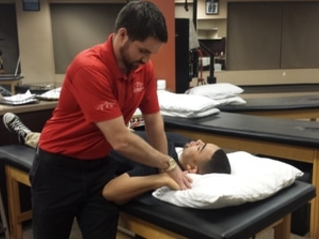- Home
- About Us
- TSPT Academy
- Online Courses
-
Resources
- Newsletter
- Business Minded Sports Physio Podcast
- Day in the Life of a Sports PT
- Residency Corner
-
Special Tests
>
-
Cervical Spine
>
- Alar Ligament Test
- Bakody's Sign
- Cervical Distraction Test
- Cervical Rotation Lateral Flexion Test
- Craniocervical Flexion Test (CCFT)
- Deep Neck Flexor Endurance Test
- Posterior-Anterior Segmental Mobility
- Segmental Mobility
- Sharp-Purser Test
- Spurling's Maneuver
- Transverse Ligament Test
- ULNT - Median
- ULNT - Radial
- ULNT - Ulnar
- Vertebral Artery Test
- Thoracic Spine >
-
Lumbar Spine/Sacroiliac Joint
>
- Active Sit-Up Test
- Alternate Gillet Test
- Crossed Straight Leg Raise Test
- Extensor Endurance Test
- FABER Test
- Fortin's Sign
- Gaenslen Test
- Gillet Test
- Gower's Sign
- Lumbar Quadrant Test
- POSH Test
- Posteroanterior Mobility
- Prone Knee Bend Test
- Prone Instability Test
- Resisted Abduction Test
- Sacral Clearing Test
- Seated Forward Flexion Test
- SIJ Compression/Distraction Test
- Slump Test
- Sphinx Test
- Spine Rotators & Multifidus Test
- Squish Test
- Standing Forward Flexion Test
- Straight Leg Raise Test
- Supine to Long Sit Test
-
Shoulder
>
- Active Compression Test
- Anterior Apprehension
- Biceps Load Test II
- Drop Arm Sign
- External Rotation Lag Sign
- Hawkins-Kennedy Impingement Sign
- Horizontal Adduction Test
- Internal Rotation Lag Sign
- Jobe Test
- Ludington's Test
- Neer Test
- Painful Arc Sign
- Pronated Load Test
- Resisted Supination External Rotation Test
- Speed's Test
- Posterior Apprehension
- Sulcus Sign
- Thoracic Outlet Tests >
- Yergason's Test
- Elbow >
- Wrist/Hand >
- Hip >
- Knee >
- Foot/Ankle >
-
Cervical Spine
>
- I want Financial Freedom
- I want Professional Growth
- I want Clinical Mastery
Posterior-Anterior Segmental Mobility
Purpose: To assess for segmental motion and the effect it has on the patient’s symptoms.
Test Position: Prone.
Performing the Test: Stand at the head of the patient, facing the patient’s feet. Place thumbs on the spinous process to be tested. Keep your elbows straight and directly over the segment to be tested. Apply anteriorly directed force through thumbs using your trunk until pain or end range is acquired. Determine the amount of motion achieved (hypomobile, normal, hypermobile) or contributions of pain. Repeat on other segments. Test can also be performed while kneeling on table at side of patient facing patient’s head. Again place thumbs or thumb and 2nd digit (to cup the spinous process) over spinous process and apply anteriorly directed force through torso. Use whichever hand-hold is most comfortable and stresses your joints, as the examiner, the least.
Diagnostic Accuracy: Sensitivity: .82; Specificity: .79; -LR: .23; +LR: 3.9 (“Validity of five common manual neck pain producing tests”).
Importance of the Test: As you apply an anteriorly directed force on the spinous process of a vertebra, you induce a flexion motion of that vertebra relative to the inferior vertebra, and an extension motion of that vertebra relative to the superior vertebra. This test can be used to determine how much motion is available at each segment. If a joint is restricted throughout or just unilaterally, that can aid in determining the pathology and treatment plan. A thorough understanding of the spine’s osteology, arthrology, and arthrokinematics can help in understanding the results of your segmental testing. For example, in the fully flexed cervical spine, if a vertebra appears rotated to the left, that means there is a capsular restriction on that left facet. In a fully extended cervical spine, if the vertebra appears rotated to the left, that means there is a capsular restriction on the right facet.
Note: tests should only be performed by a properly trained health care practitioner.
Test Position: Prone.
Performing the Test: Stand at the head of the patient, facing the patient’s feet. Place thumbs on the spinous process to be tested. Keep your elbows straight and directly over the segment to be tested. Apply anteriorly directed force through thumbs using your trunk until pain or end range is acquired. Determine the amount of motion achieved (hypomobile, normal, hypermobile) or contributions of pain. Repeat on other segments. Test can also be performed while kneeling on table at side of patient facing patient’s head. Again place thumbs or thumb and 2nd digit (to cup the spinous process) over spinous process and apply anteriorly directed force through torso. Use whichever hand-hold is most comfortable and stresses your joints, as the examiner, the least.
Diagnostic Accuracy: Sensitivity: .82; Specificity: .79; -LR: .23; +LR: 3.9 (“Validity of five common manual neck pain producing tests”).
Importance of the Test: As you apply an anteriorly directed force on the spinous process of a vertebra, you induce a flexion motion of that vertebra relative to the inferior vertebra, and an extension motion of that vertebra relative to the superior vertebra. This test can be used to determine how much motion is available at each segment. If a joint is restricted throughout or just unilaterally, that can aid in determining the pathology and treatment plan. A thorough understanding of the spine’s osteology, arthrology, and arthrokinematics can help in understanding the results of your segmental testing. For example, in the fully flexed cervical spine, if a vertebra appears rotated to the left, that means there is a capsular restriction on that left facet. In a fully extended cervical spine, if the vertebra appears rotated to the left, that means there is a capsular restriction on the right facet.
Note: tests should only be performed by a properly trained health care practitioner.
References:
Sandmark H, Nisell R. "Validity of five common manual neck pain producing tests." Scand J Rehabil Med. 1995 Sep. Web. 08/18/2012.
Sandmark H, Nisell R. "Validity of five common manual neck pain producing tests." Scand J Rehabil Med. 1995 Sep. Web. 08/18/2012.
Copyright © The Student Physical Therapist LLC 2023




